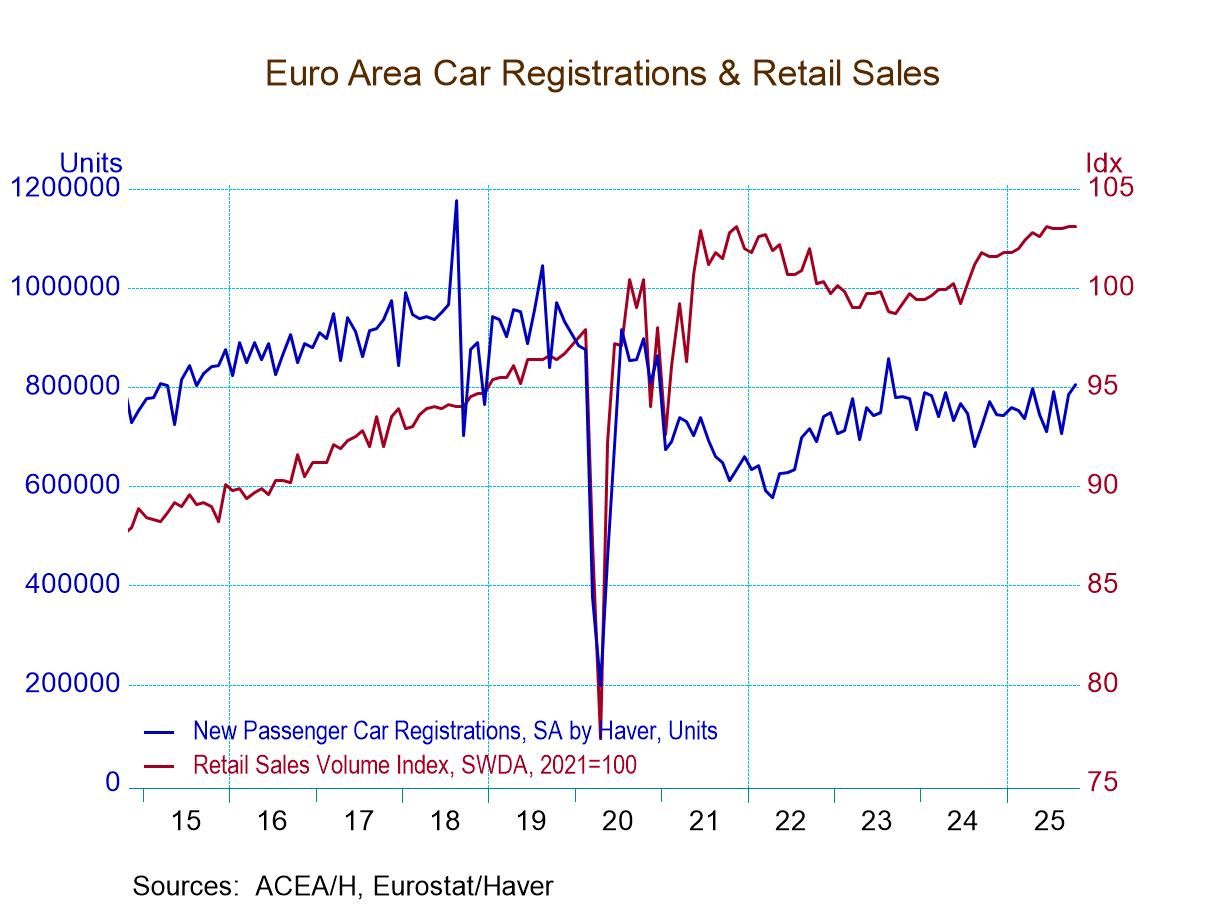 Global| Oct 18 2006
Global| Oct 18 2006Old News: Euro-Zone Trade Suffers from High Energy Costs in August, Too
Summary
In July and August, the Euro-Zone region had its largest two-month trade deficit in the 17-plus-year history* of these combined regional data. In July, the deficit reached 6.2 billion and improved just slightly in August to 5.5 [...]

In July and August, the Euro-Zone region had its largest two-month trade deficit in the 17-plus-year history* of these combined regional data. In July, the deficit reached €6.2 billion and improved just slightly in August to €5.5 billion. These are tiny by US standards, but the more normal pattern in Europe is a trade surplus with the rest of the world, which just four years ago reached €8.2 billion.
July's deficit suffered from a decrease in exports of 2.0%, but these rebounded in August by 3.2%. They are a quite respectable 7.4% ahead of a year ago, a pace that has been equaled or exceeded in most months since the middle of 2003, when a two-and-a-half year recession ended in Germany. Manufactured goods led the way.
Imports rose 2.2% in July and 2.4% in August. August's inflows of merchandise were 10.3% ahead of a year ago. It is easy to say "oil is a major culprit", and it is, with the mineral fuel category up €3.7 billion, or 13.8%. However, manufactured goods are just as significant. "Other" manufactured goods" (excluding machinery and chemical products) are up €3.4 billion, or 14.5%. The European economy has been strong, and this is reflected in its demand for imported goods.
We title this article "Old News", since these data, of course, cover August. Since then, oil and gasoline prices have fallen dramatically. So we would hope that succeeding months' trade reports will look more favorable for oil importers.
*In this commentary we have used Haver's EUROSTAT database, which comes from Eurostat, and also our own summary compilation, G10+. Eurostat's seasonally adjusted data run back to 1989, hence our reference to the "17-year" history of the series. Eurostat's adjustment methods are called "TRAMO" and "SEATS", which take explicit account of "working days". In G10, Haver has run its own seasonal adjustment using the more familiar X-12 ARIMA technique. The series adjusted this way extend back to 1980, the same as the not seasonally adjusted data. Depending on your analytical needs, either or both of these datasets may be useful for your work.
| France, SA, Mil.€ | Aug 2006 | July 2006 | June 2006 | Aug 2005 | Monthly Averages|||
|---|---|---|---|---|---|---|---|
| 2005 | 2004 | 2003 | |||||
| Trade Balance | -5,454 | -6,262 | -1,324 | -1,695 | +1,658 | +5,958 | +5,797 |
| Exports | 114,739 | 111,138 | 113,460 | 107,329 | 103,191 | 96,068 | 88,199 |
| % Change | 3.2% | -2.0% | 0.8% | 7.4% | 7.4% | 8.9% | -2.3% |
| Imports | 120,193 | 117,361 | 114,783 | 109,004 | 101,533 | 90,110 | 82,402 |
| % Change | 2.4% | 2.2% | -0.0% | 10.3% | 12.7% | 9.4% | 0.5% |
Carol Stone, CBE
AuthorMore in Author Profile »Carol Stone, CBE came to Haver Analytics in 2003 following more than 35 years as a financial market economist at major Wall Street financial institutions, most especially Merrill Lynch and Nomura Securities. She had broad experience in analysis and forecasting of flow-of-funds accounts, the federal budget and Federal Reserve operations. At Nomura Securities, among other duties, she developed various indicator forecasting tools and edited a daily global publication produced in London and New York for readers in Tokyo. At Haver Analytics, Carol was a member of the Research Department, aiding database managers with research and documentation efforts, as well as posting commentary on select economic reports. In addition, she conducted Ways-of-the-World, a blog on economic issues for an Episcopal-Church-affiliated website, The Geranium Farm. During her career, Carol served as an officer of the Money Marketeers and the Downtown Economists Club. She had a PhD from NYU's Stern School of Business. She lived in Brooklyn, New York, and had a weekend home on Long Island.





